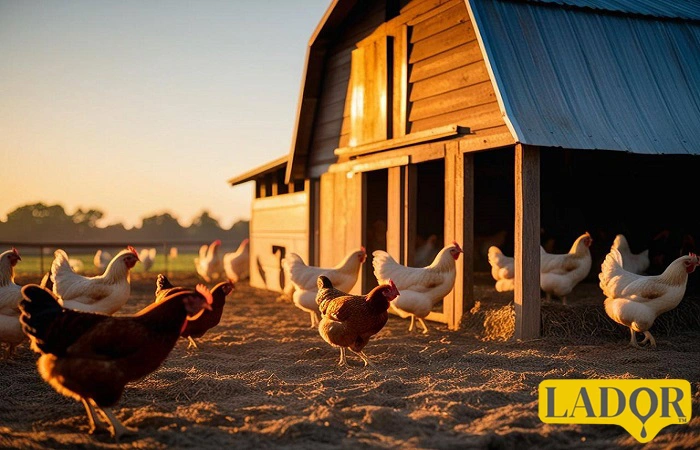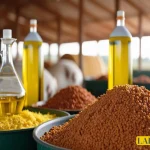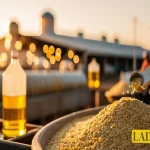chicken-Starter-Feed is a product industrially designed and produced with a specific formulation to feed various types of birds. These feeds, tailored to the specific nutritional needs of different species and ages of birds, contain a balanced mix of nutrients such as protein, fat, carbohydrates, vitamins, minerals, and other essential elements for the growth and health of birds. In this article, we aim to discuss ready-to-use poultry feed, its features, components, and its beneficial effects on poultry. Please stay with us until the end.
Why use ready-to-use poultry feed?
Using ready-to-use poultry feed provides all the necessary nutrients for birds, eliminating the need for manual mixing of different food items. This feed promotes weight gain, improves feather quality, strengthens the immune system, and reduces diseases in poultry. In laying hens, the use of ready-to-use feed also increases the number and quality of eggs. Additionally, by optimally utilizing ready-to-use poultry feed, feeding costs are reduced, making it highly significant for large poultry farms.
Factors affecting the choice of feed type
Type of poultry: Each type of poultry has its specific nutritional needs.
Age of poultry: The nutritional needs of young chicks differ from adult birds.
Production stage: Nutritional needs vary at different stages of production, such as growth, egg laying, and reproduction.
Environmental conditions: Temperature, humidity, and other environmental factors influence the nutritional needs of poultry.
Ready-to-use Poultry Feed Production Process
The production of ready-to-use poultry feed is a precise and multi-step process aimed at meeting all the nutritional needs of poultry. Below are the main stages of this process:
Feed Formulation
- Determining nutritional requirements: Nutritionists specify the exact nutritional needs based on the type of poultry (meat, egg-laying), their age, and environmental conditions.
- Selecting raw materials: Based on the formulation, suitable raw materials such as grains, oilseed meals, fats, vitamins, minerals, and additives are selected.
Raw Material Preparation
- Grinding: Solid raw materials like grains and oilseed meals are ground into very fine particles to increase their digestibility.
- Mixing: The ground materials are combined with vitamins, minerals, and other additives in industrial mixers to create a homogeneous mixture.
- Pelleting (optional): In some cases, the resulting mixture is formed into pellets of specific sizes. Pellets, due to their uniform shape and size, are easier to transport and store and also prevent the waste of food.
Quality Control
- Various tests: Throughout the production process, samples of the feed are taken and tested for moisture content, nutrients, microbial contamination, and other parameters.
- Packaging: The ready-to-use feed is packaged in suitable bags and prepared for distribution.
Types of Ready-to-use Poultry Feed
Ready-to-use poultry feeds are classified into different types based on age, type of poultry, and production stage:
- Day-old chicks: Contains a high amount of protein and energy for rapid chick growth.
- Starter feed: Used for growing chicks and contains a balanced amount of protein and energy.
- Grower feed: Used for older chicks and contains less protein compared to starter feed.
- Finisher feed: Used for adult hens and contains more calcium for egg production.
- Broiler feed: Designed for broiler chickens and contains high energy for rapid weight gain.
- Layer feed: Designed for laying hens and contains high calcium for eggshell production.

Main Ingredients of Ready-to-use Poultry Feed
Ready-to-use poultry feed is a combination of nutrients that are precisely and proportionally formulated to meet the different needs of poultry species and their ages. These feeds typically include the following ingredients:
Plant-based raw materials:
- Grains: Corn, wheat, barley, millet, etc. Grains are the main source of energy in poultry diets and provide the energy necessary for the bird’s vital activities due to their carbohydrates.
- Oilseed meals: Soybean meal, sunflower meal, etc. These materials are a rich source of protein and are essential for the growth and repair of the bird’s body tissues.
- By-products: Beet pulp, apple pulp, etc. These materials contain fiber and some other nutrients and help improve digestive function.
Animal-based raw materials:
- Fish meal: A high-quality protein source containing essential amino acids for poultry growth.
- Meat and bone meal: A source of protein, calcium, and phosphorus, essential for bone formation and eggshells.
- Blood meal: A source of protein and iron.
Other additives:
- Vitamins: A complete set of vitamins such as A, D, E, K, and B vitamins are essential for maintaining the health and proper function of the bird’s body.
- Minerals: Calcium, phosphorus, sodium, potassium, magnesium, and trace elements such as iron, copper, zinc, and selenium are essential for bone formation, nerve and muscle function, and other vital processes.
- Enzymes: Used to improve the digestion and absorption of nutrients from food.
- Probiotics: Beneficial microorganisms that help improve gut health and strengthen the immune system.
- Prebiotics: Compounds that stimulate the growth of beneficial gut bacteria.
Why vitamins and minerals are important in poultry nutrition?
Vitamins and minerals play a very important role in the growth, reproduction, and health of poultry. A deficiency of any of them can lead to serious health problems and reduced production performance. Some of the most important vitamins and minerals needed by poultry include:
- Vitamin A: For vision, bone growth, and immune system
- Vitamin D: For calcium absorption and strengthening bones
- Vitamin E: For cell protection and improving the immune system
- Calcium: For eggshell and bone formation
- Phosphorus: For bone and tooth formation
- Magnesium: For muscle and nerve function
Difference between ready-made and homemade feed for poultry
Poultry feed is divided into two main categories: ready-made and homemade. Each has its advantages and disadvantages, which will be discussed below.
Ready-made Poultry Feed
Advantages:
- Balanced nutrition: Precise and scientific formulation to meet all nutritional needs of poultry.
- Ease of use: Ready-to-use and does not require manual mixing of food.
- Reduced errors: Lower probability of nutrient deficiencies or excesses.
- Consistent quality: Raw material quality and production process are controlled.
- Wide variety: Different types of ready-made feed are available for various ages and breeds of poultry.
Disadvantages:
- Higher cost: Usually more expensive than homemade feed.
- Dependence on the manufacturer: You may face difficulties if ready-made feed is unavailable or in short supply.
Homemade Poultry Feed
Advantages:
- Lower cost: Reduces feeding costs by using cheaper raw materials.
- Complete control over food: You can choose higher quality and more natural raw materials.
Disadvantages:
- Imbalanced nutrition: There is a possibility of nutrient deficiencies or excesses.
- Time-consuming and laborious: Requires manual mixing of food and takes a lot of time.
- Variable quality: The quality of raw materials and their combination may change continuously.
- Risk of contamination: There is a higher risk of food contamination with microbes and parasites.

Common Poultry Diseases and the Role of Nutrition in Prevention
Improper nutrition and nutrient deficiencies can weaken the immune system and increase poultry susceptibility to diseases. Some common poultry diseases and the role of nutrition in their prevention include:
- Marek’s disease: A deficiency of vitamin E and selenium can increase the risk of this disease.
- Coccidiosis: Feeding with feed containing anticoccidials can prevent this disease.
- Newcastle disease: Strengthening the immune system through proper nutrition can help poultry resist this disease.
- Avian influenza: Proper nutrition and hygiene can reduce the risk of this disease.
Important Points to Consider When Using Ready-made Poultry Feed
- Choosing the right feed
- Checking production and expiration dates
- Providing clean and ample water
- Maintaining proper hygiene
- Consulting a veterinarian
Conclusion
Overall, ready-made feed is more suitable for industrial poultry farming due to its balanced nutrition, ease of use, and consistent quality. However, for small-scale farming and meeting household needs, preparing homemade feed can also be a good option. Using ready-made feed with a precise formulation and providing all the nutritional needs of poultry is the best way to maintain their health and improve their performance.
Ala Sepahan Oil Factory under the brand name Ladorfat produces raw materials for all types of aquatic and poultry feed, and besides producing feed raw materials, it also produces and markets various types of powders and industrial and livestock oils. To inquire about the price, contact our experts at Ladraft Company.



